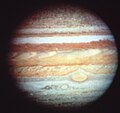English: This is the first true-color photograph of the giant planet Jupiter from the Wide Field Planetary Camera on NASA's Hubble Space Telescope. All features in this image are cloud formations in the atmosphere of Jupiter, which contain small crystals of frozen ammonia and traces of colorful chemical compounds of carbon, sulfur, and phosphorus. The temperatures of the clouds are extremely cold, about -280 degrees F.
The photograph was generated in a computer by combining three separate WFIPC exposures, which were made in red, green and blue light at 4:34 a.m. EDT on May 28, 1991. It is part of a sequence of 45 exposures taken during an interval of 32 hours through five different colored filters as part of an ongoing study of the dynamic cloud and wind systems on Jupiter.
Jupiter's famous "Great Red Spot," a centuries old, hurricane-like formation that is large enough to more than encompass the whole Earth, is visible at the lower right. The Great Red Spot is seen here to be producing an unusual tent-shaped structure on the edge of Jupiter's South Equatorial Belt, the horizontal dark band just above (north of) the Spot. To the left and below the Spot, there is a so- called white oval, one of several that formed in or about 1940.
The photograph shows much more detail than can be seen with telescopes on the ground, and thus provides a sharp view for comparison with the images obtained during brief intervals in 1973-74 by NASA's Pioneer 10 and 11 space probes, and in 1979 during tile Jupiter encounters of Voyager 1 and Voyager 2. The colors and features of Jupiter's belted atmosphere change from year to year, so that Jupiter looks quite different than it did during the spacecraft encounters. The Hubble Space Telescope will be photographing Jupiter periodically so that the "weather" on the great gases planet can be studied systematically without long intervening gaps.
The Wide Field Planetary Camera was designed and built at the Pasadena-based Jet Propulsion Laboratory, managed by the California Institute of Technology for NASA.





